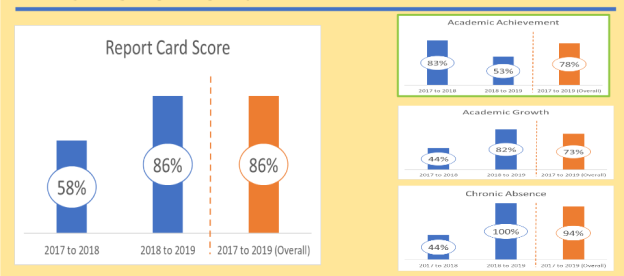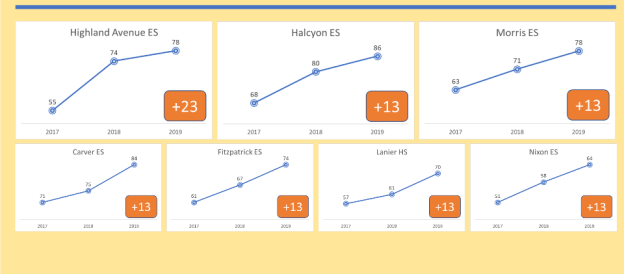In a well-run school district, students are not the only ones who need to meet high standards. Every aspect of the system—from school governance and finance to curriculum and instruction—needs to be held to a high standard. Cognia’s role as an accreditor is to review evidence of performance and assure policy makers and the public that schools and districts meet gold-standard criteria of top-flight institutions and systems.
Early in 2018, I was called in to lead the Montgomery, Alabama schools after a state takeover of the system in 2017. The district was in bad shape. A Cognia™ (then AdvancED) Diagnostic Review pinpointed 31 areas where the district failed to meet the standards and needed improvement. The report and our own internal review of the district’s status revealed serious challenges.
Resources: The district had no chief financial officer, which was a significant deficit, and had not filed monthly financial reports with the state department of education for several years. Further, it could not muster the cash reserves required by the state.
Governance and leadership: Cognia determined that the district failed to meet nine of the 11 standards for school governance. The school board was interfering in district day-to-day operations and needed to reexamine its roles and responsibilities. The board could not function well as a team and needed to play a stronger role in overseeing—but not implementing—improvement efforts. The district’s policy manual was 35 years old, and the school board bylaws hadn’t been updated in decades.
Learning and student achievement: Cognia said that the district needed improvement in numerous domains, including:
- Giving learners equitable opportunities to develop skills and achieve the content and learning priorities established by the district
- Creating a learning culture that promotes creativity, innovation, and collaborative problem solving
- Developing learners’ attitudes, beliefs and skills needed for success
By most performance indicators, the district was underperforming. About four in 10 schools were showing no improvement, and the state intervention letter listed among its reasons for taking over the schools that the district had low proficiency scores, low graduation rates, and high chronic absentee rates.
Data: Achievement data was readily available but was not being used to inform improvements. Information systems that tracked key areas of performance, such as absenteeism and college and career readiness, provided inaccurate information that made the district’s outcomes look worse than they were. Teachers were burdened by the systems, because providing the information was cumbersome and not intuitive.
Accreditation for motivation and leverage
A key moment in the district’s recovery was the presentation of Cognia’s report to the school board. Cognia President and CEO Dr. Mark Elgart made it clear to the board and the public that Montgomery County Schools was in danger of losing accreditation. The report and presentation were a major black eye for the district but scared stakeholders into action and gave us the leverage we needed to make changes.
In addition to creating motivation, Cognia’s report formed the basis of my roadmap to move forward. We organized a district leadership team to develop a process to meet every standard and received regular, timely feedback from Cognia to let us know we were moving in the right direction.
In addition to creating motivation, Cognia’s report formed the basis of my roadmap to move forward. We organized a district leadership team to develop a process to meet every standard and received regular, timely feedback from Cognia to let us know we were moving in the right direction.
From the start, my team worked with school principals and central office staff to address specific concerns. We discussed how to implement the strategic plan and what schools were already doing, and gathered feedback from each other. We said to school leaders, “We want you to cover these issues in faculty meetings,” and assigned central office staff to attend the meetings and oversee implementation, saying we were “just checking,” which was quite unusual for the district. We monitored the roadmap to be sure that were making progress in every area.
Upgrading data systems
To authentically demonstrate baseline status and improvement results, we needed to prioritize improvement in this area. Based on the findings about the underutilization of achievement data, the inaccuracy of some of our information, and the drag on teachers to actually enter data into our system, the district scrupulously reviewed and re-engineered how information was captured and reported, making it easier for teachers to report accurate information.
Improving student engagement and instruction
Cognia provided professional learning on how to use the Effective Learning Environments Observation Tool® (eleot®). We then used data from thousands of classroom observations to determine steps that would improve student engagement and educator effectiveness. There was significant buy-in from teachers because the implementation was teacher-led and thus could be trusted. Cognia trained and certified teachers to use the eleot, and the district organized additional professional learning led by exemplar teachers from each school who could model effective approaches and support their colleagues at the building level.
School board training
Cognia trained the board to stay in its lane, set goals, and practice new norms of communications, problem solving, and behavior. (See the related article in this issue: Helping School Boards Lead.)
Moving to solid financial ground
Although Montgomery is the capital of Alabama and its fourth-largest city, it is not a wealthy community. Local schools have traditionally been underfunded and dependent on state subsidies. The city’s local tax base provides a third of what other districts, like Huntsville, can provide, and one-tenth of what Hoover, the largest suburb of Birmingham, provides to schools.
When I arrived, the district had run out of local funds and had to operate from the state subsidy. To put the district in the black (and meet state fiscal requirements) we had to cut staff, which required careful analysis of staff allocations across the district. We determined we needed to cut 100 positions. We apologized to the staff, explaining that we couldn’t continue taking money for basic services out of the general fund and needed to operate within our means. I made sure that the positions were cut across job categories. To show good faith to the staff, the central office took the biggest hit, cutting $2 million from our staff budget. Everyone in the central office has been doing the work of two or three people.
The Turnaround
It has taken time—and distance learning during COVID-19 has slowed progress—but since 2018 when I took over, the district has shown significant improvement. The district earned Cognia Accreditation in 2020 and the state Board of Education has removed the district from state intervention, effective December 2021.
We’ve demonstrated distinct progress in multiple areas.
Student achievement. Though further improvement is still needed, the district met all Cognia’s performance standards for student learning by 2020.
- From 2018 through 2019, we improved math and reading scores; but like most districts, we have not done as well with remote classes as with face-to-face learning.
- The percentage of schools showing improvement rose from 58 percent in 2017–18 to an average of 86 percent over the next two years.
- Our attendance rates more than doubled from 44 percent in 2017 to an average of 94 percent over the next two years.
- Indicators of college readiness also have risen significantly.
- We have been able to use new resources to focus more on academic support for students. This summer, we had 12,000 students in summer program when we normally enroll 2,500.
- Equally gratifying, the district showed significant continuous improvement across many of its elementary schools
Montgomery County Percentage of Schools Showing Improvement by Accountability Report Card Score and Indicator 2017-2019.

Montgomery County Highest-Improved Schools by Accountability Report Card Score 2017-2019.

Fiscal responsibility. The district now has a reserve of $58 million—three times the state requirement.
Public support. The public is gaining confidence in the district.
- We are no longer under state control and have maintained our accreditation.
- We had a referendum on a local tax increase for schools and, for the first time in 50 years, voters agreed to raise the local tax levy for our schools.
Governance. The board and the superintendent are getting along, and decisions are made on a rational basis.
- The board recognizes the significance of its input when they get to vote yes or no on issues.
- Relations have improved among board members and with the central office.
- It is now our practice to work on the thorniest issues out of the public eye and get down to business at board meetings.
Data systems. The district carefully studied how it obtained information in every area of performance and redesigned the system to ensure accuracy, ease of use, and ways in which data could better inform instruction and decision-making.
A New Narrative
In Montgomery, we want to meet the highest standards in everything we do. And we want the public to know about it. For many years, the community had grown complacent about the district’s performance. When something would happen, they would roll their eyes and say, “Oh, that’s just Montgomery Public Schools.” But now the narrative has changed. We let our community know what we have done. We post billboards about all our latest achievements. Now, if I go to the grocery store, people will recognize me and say, “You’re the lady superintendent. You’re doing a good job.”
The hardest part is over. We have met Cognia’s standards and have consequentially been released from state control, and we have new ways of doing business that we can follow on a routine basis. The next review will be smooth sailing because excellence is what we do every day.
I will retire from Montgomery schools in July 2022 to pursue other challenges. As I reflect, I’m grateful to the state for stepping in and ensuring that the district demonstrated it could transform itself. I’m also grateful to Montgomery’s educators for rising to the challenge, for the county’s vote for new resources, and to my board members for supporting new directions. And I’m grateful to Cognia. Without the fear of losing accreditation and the roadmap, and all the tools and support, many of these changes would not have been possible.
You might also be interested in Helping School Boards Lead.
© Cognia Inc.
This article may be republished or reproduced in accordance with The Source Copyright Policy.
The information in this article is given to the reader with the understanding that neither the author nor Cognia is in engaged in rendering any legal or business advice to the user or general public. The views, thoughts, and opinions expressed in this article belong solely to the author(s), and do not necessarily reflect the official policy or position of Cognia, the author’s employer, organization, or other group or individual.

